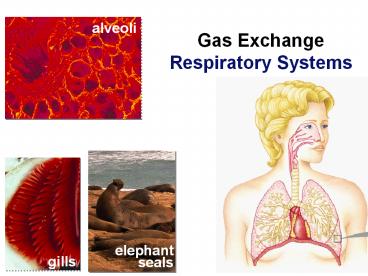gills - PowerPoint PPT Presentation
1 / 27
Title: gills
1
alveoli
Gas Exchange Respiratory Systems
elephantseals
gills
2
(No Transcript)
3
Why do we need a respiratory system?
- Need O2 in
- for aerobic cellular respiration
- make ATP
- Need CO2 out
- waste product fromKrebs cycle
4
Gas exchange
- O2 CO2 exchange between environment cells
- need moist membrane
- need high surface area
5
Optimizing gas exchange
- Why high surface area?
- maximizing rate of gas exchange
- CO2 O2 move across cell membrane by diffusion
- rate of diffusion proportional to surface area
- Why moist membranes?
- moisture maintains cell membrane structure
- gases diffuse only dissolved in water
6
Gas exchange in many forms
amphibians
one-celled
echinoderms
insects
mammals
fish
endotherm vs. ectotherm
size
water vs. land
7
Evolution of gas exchange structures
- Aquatic organisms
external systems with lots of surface area
exposed to aquatic environment
Terrestrial
moist internal respiratory tissues with lots of
surface area
8
Gas Exchange in Water Gills
9
Counter current exchange system
- Water carrying gas flows in one direction, blood
flows in opposite direction
10
How counter current exchange works
back
front
70
40
100
15
water
60
30
90
counter-current
5
blood
50
70
100
50
30
5
concurrent
- Blood water flow in opposite directions
- maintains diffusion gradient over whole length of
gill capillary - maximizing O2 transfer from water to blood
11
Gas Exchange on Land
- Advantages of terrestrial life
- air has many advantages over water
- higher concentration of O2
- O2 CO2 diffuse much faster through air
- respiratory surfaces exposed to air do not have
to be ventilated as thoroughly as gills - air is much lighter than water therefore much
easier to pump - expend less energy moving air in out
- Disadvantages
- keeping large respiratory surface moist causes
high water loss - reduce water loss by keeping lungs internal
12
Terrestrial adaptations
Tracheae
- air tubes branching throughout body
- gas exchanged by diffusion across moist cells
lining terminal ends, not through open
circulatory system
13
Lungs
Exchange tissuespongy texture, honeycombed with
moist epithelium
14
Alveoli
- Gas exchange across thin epithelium of millions
of alveoli - total surface area in humans 100 m2
15
Negative pressure breathing
- Breathing due to changing pressures in lungs
- air flows from higher pressure to lower pressure
- pulling air instead of pushing it
16
Mechanics of breathing
- Air enters nostrils
- filtered by hairs, warmed humidified
- sampled for odors
- Pharynx ? glottis ? larynx (vocal cords) ?
trachea (windpipe) ? bronchi ? bronchioles ? air
sacs (alveoli) - Epithelial lining covered by cilia thin film
of mucus - mucus traps dust, pollen, particulates
- beating cilia move mucus upward to pharynx,
where it is swallowed
17
Autonomic breathing control
- Medulla sets rhythm pons moderates it
- coordinate respiratory, cardiovascular systems
metabolic demands - Nerve sensors in walls of aorta carotid
arteries in neck detect O2 CO2 in blood
18
Medulla monitors blood
- Monitors CO2 level of blood
- measures pH of blood cerebrospinal fluid
bathing brain - CO2 H2O ? H2CO3 (carbonic acid)
- if pH decreases then increase depth rate of
breathing excess CO2 is eliminated in exhaled
air
19
Breathing and Homeostasis
- Homeostasis
- keeping the internal environment of the body
balanced - need to balance O2 in and CO2 out
- need to balance energy (ATP) production
- Exercise
- breathe faster
- need more ATP
- bring in more O2 remove more CO2
- Disease
- poor lung or heart function breathe faster
- need to work harder to bring in O2 remove CO2
20
Diffusion of gases
- Concentration gradient pressure drives movement
of gases into out of blood at both lungs body
tissue
capillaries in lungs
capillaries in muscle
blood
lungs
blood
body
21
Hemoglobin
- Why use a carrier molecule?
- O2 not soluble enough in H2O for animal needs
- blood alone could not provide enough O2 to animal
cells - hemocyanin in insects copper (bluish/greenish)
- hemoglobin in vertebrates iron (reddish)
- Reversibly binds O2
- loading O2 at lungs or gills unloading at cells
heme group
cooperativity
22
Cooperativity in Hemoglobin
- Binding O2
- binding of O2 to 1st subunit causes shape change
to other subunits - conformational change
- increasing attraction to O2
- Releasing O2
- when 1st subunit releases O2, causes shape
change to other subunits - conformational change
- lowers attraction to O2
23
Transporting CO2 in blood
- Dissolved in blood plasma as bicarbonate ion
carbonic acid CO2 H2O ? H2CO3 bicarbonate H
2CO3 ? H HCO3
carbonic anhydrase
24
Releasing CO2 from blood at lungs
- Lower CO2 pressure at lungs allows CO2 to diffuse
out of blood into lungs
25
Adaptations for pregnancy
- Mother fetus exchange O2 CO2 across placental
tissue
26
Fetal hemoglobin (HbF)
- HbF has greater attraction to O2 than Hb
- low O2 by time blood reaches placenta
- fetal Hb must be able to bind O2 with greater
attraction than maternal Hb
What is the adaptive advantage?
2 alpha 2 gamma units
27
Dont be such a baby Ask Questions!!































